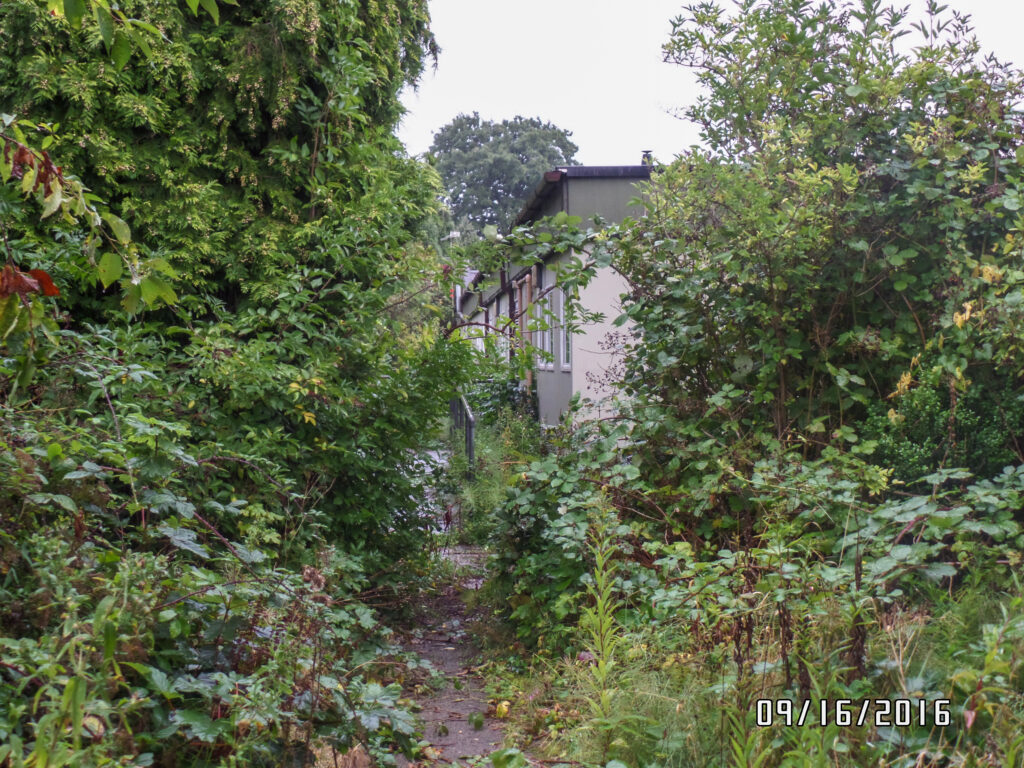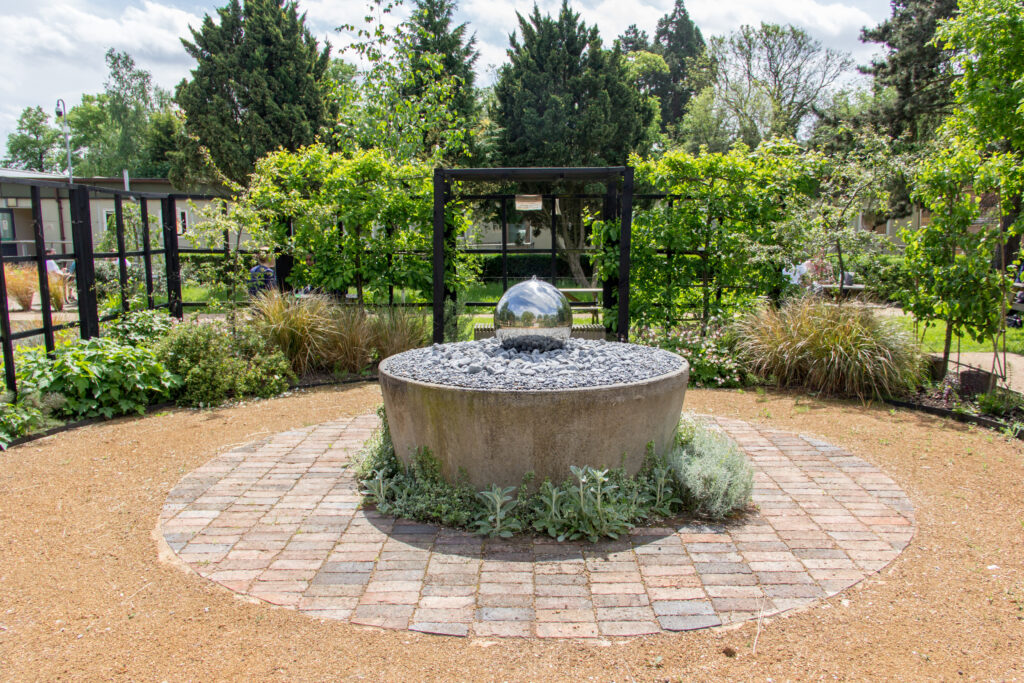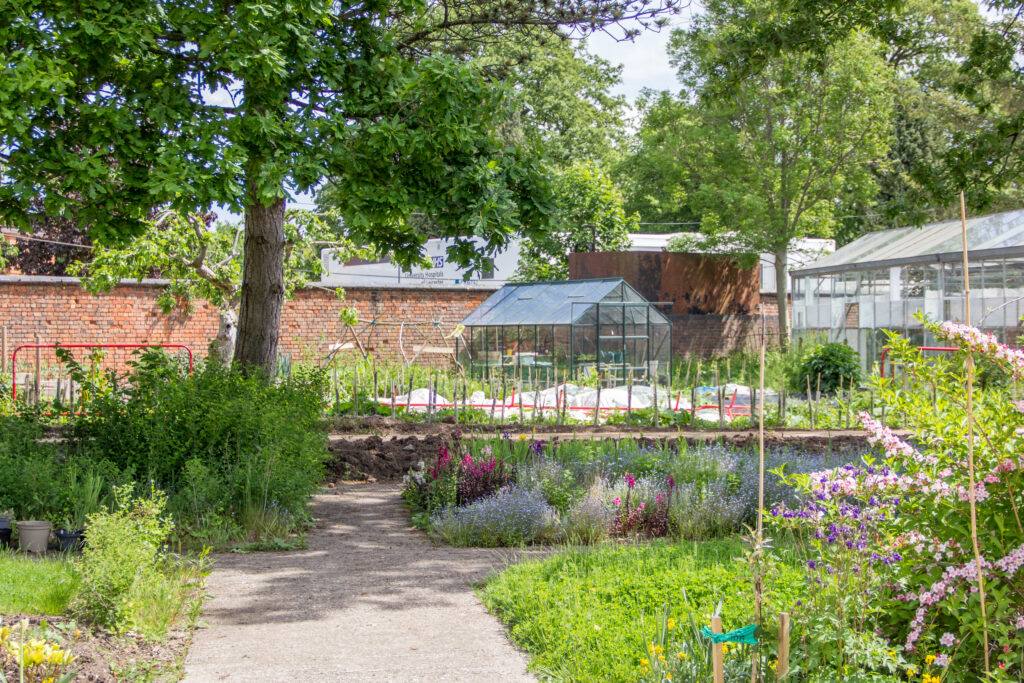Karen James is the Commercial Services Manager at Glenfield Hospital in Leicester, and the driving force behind the transformation of its incredible Secret Garden. She tells the NHS Forest how a chance encounter with a grapevine and a memorial bench led to the creation of this lush green space with its many hidden gardens, which has become a restorative space for patients and staff, and a thriving community hub.
Seeding an idea
I originally came in October 2016. I looked out the window and I saw what I thought was a grapevine. So I asked one of my colleagues, “Is there a garden out there? Because all I can see is brambles.”He told me it used to be a sensory garden as part of a Mental Health Unit, run by one of our partner organisations. We ventured out and we couldn’t get too far because of the 12-foot-high brambles. Then I found a bench with a commemorative plaque, saying it was donated in memory of somebody’s daughter, who’d been a service user at the centre. That started to pull at my heartstrings because for them to make that donation, this space meant a lot to them, and if they ever came back to see it in the state it was in now, how upsetting that would be. As a mother myself, if I’d lost a child and she had many happy memories, I’d like to be able to go back and revisit the place that was very special to her.


I’m not frightened of a challenge. I thought – we could do something good with this. It would be a shame to let it just go, nature taking hold. I spoke to our then Director of Estates and Facilities and explained what I thought we could do with it, and he said, “You can have a project, but there’s no budget. Do with it what you will.” That started the ball rolling. I’d only been with the trust a very short time, but there were a lot of colleagues here who remembered this site. We started by having conversations with them, and that’s where the journey started.
The work begins
For about 18 months, all we did was clear the site so we could see what space we’d got and what was underneath it. The Community Payback team [offenders who on projects to pay back the community] came in and cleared it. We had skips donated by a local skip company because there was a lot of debris to remove. A lot of trees were diseased, unfortunately, so we had to lose quite a lot of them. We got it down to what I call ‘ground zero,’ so we could see what we were up against.
Throughout this period I had lots of meaningful conversations with potential beneficiary groups for me to be able to understand how I thought we could use the garden. And it was interesting to hear, not just from the people who used to work here, but from people who said they would like to use the space and how it would link in with the work that they were doing with clinicians.
A garden built on goodwill
An architect donated a lot of his time to draw up this vision I had in my head, to be able to present to people. After that, we were trying to access the funds to deliver what was inside my head, my vision, if you like. We’re very lucky that we were picked up by Channel 5’s Great Garden Challenge, because we got four gardens in the semi-final. It was for up-and-coming young talent, and we had to give them a brief. I used the conversations that I’d had with the potential beneficiary groups to explain what we wanted from their designs. And thankfully, as you’ve seen, they came up with four beautiful gardens for us. Although I’d been talking to people and saying, “this is what I want,” it was very difficult to get people to open the cheque books, because they couldn’t see anything. But once we got the four gardens, we could invite them to the site and say, “this is what we’ve achieved,” it made it more visible for people to be able to say, “well, actually, we could give you a little donation to put towards something.”


During the pandemic, with the NHS – and what the staff were going through – being so high profile, a lot of companies were coming forward offering support, and the garden of reflection and remembrance was done. A local chainsaw artist came and gave his time to create these beautiful sculptures. For him to create that piece of art for our staff to enjoy, that will be his legacy. They were carved from the original trees that we had to have cut down because of disease. For other areas, we raised the funds. The kids from the National Citizen Service did a lot of fundraising for us and raised £5,000.
The builder who got the contract to do the work donated the centrepiece in memory of his dad, because he could see what we’re trying to achieve. If you look at gestures of goodwill, people’s time and money raised to date, we’ve had in excess of £600,000. We are looking at a new project to soften the big wall at the back, for people who want a memorial plaque. It’s not just to commemorate someone who’s passed; it could be for a golden wedding anniversary, the birth of a child, an engagement or a wedding, or as a thank you. We don’t want it just to become a memorial wall; we want it to become a memory wall. So it can reflect a different memory for whatever’s personal to that person.
A multi-purpose space for staff
In the summer, the garden becomes an outdoor meeting venue for staff. We get a lot of team briefs out here, a lot of one-to-ones, annual appraisals… It’s much better to do that outside because people feel more relaxed, and you tend to get more from the conversation. The Mediterranean Garden becomes an outdoor meeting room because it’s got a pagoda with two benches and a big table. Whereas the other pagoda at the back – that’s small, it’s got more secluded spaces. So people just sit and read or they have that quiet time because they’re more enclosed in the greenery.


The wildlife area – people just sit there and look at that tree when it’s in blossom. You watch the birds come and feed in the water butt, things like that. When I walk through that gate in the morning, it’s lovely. I just stand there. All these birds twittering away. You just wouldn’t think that you’re in a busy hospital environment when you walk through that gate.
We’re linking with our health and wellbeing team to deliver activities. There’s a lunchtime programme for summer; staff can drop in and do Tai Chi, shiatsu, mindfulness, motivation sessions… Last year, we did six weeks of ‘Forest School for staff’: we just sat on a rug and did things like rock wrapping and willow stars, we had candles on the grass in jam jars.
Diverse users
The general public are starting to find out about it now as well. The local Asian Ladies Walking Group tend to pop in when they’re out on their walks. I’ve got two volunteer groups set up – the Tuesday and Friday morning groups. It’s a diverse mix of people; I think the youngest is in their twenties, right up to seventies. It’s the social interaction they come for, but they also help maintain the gardens because without them we wouldn’t be able to. We have the Community Payback team come every week, religiously, to help with the maintenance of the garden. And there’s a lot of patients who come down: outpatients who are here for appointments, or inpatients who come for therapeutic visits. Some come down with their carers, and they’ll come and sit and enjoy the fresh air – listen to the birds or have a cup of tea from the cafe. It’s just nice.
We don’t want to just hold it back for the trust. We want it to become a health and wellbeing community hub for our staff, our patients and their families, and the wider community groups that the trust serves. As much as I like it first thing in the morning when I’ve got the whole place to myself, it’s not much of a secret anymore, which is great!
If you count all the different areas, we’ve got about 152 seats. But in summer, people are having to sit on the lawn, it’s that busy. I might have to invest in picnic blankets for people when all the seats are taken! It’s great, I love it, my vision’s comes to life. When you see people enjoying using it, you just think, “Yeah, you’re not mad for imagining this and doing all this work.” I get a great sense of achievement.


Future development plans
I’d like to get the Nurture through Nature programme up and running. That’s the big one. It covers all the horticultural therapy activities, and the intention is to link it in with our occupational health team. If you’ve got somebody who’s been off sick long-term, they could be prescribed a phased return to work. And as part of that, they come and do some horticultural therapy, which eases them back into the workplace. If somebody is off with stress, they go and do a few sessions in the garden to help aid their recovery. At the other end of the scale, it could give a member of staff an interest before they retire. But it also keeps them in contact with their colleagues here rather than just a dead stop. They could join the Friday morning volunteer group, and still have that interaction with colleagues.
The organic growing area will tie in with a lot of the activity programmes. Once the raised beds are in place, people will come and learn how to grow and harvest organically, and we’ll have an outdoor kitchen where they learn how to eat healthily as well. The two things for me go hand in hand. They’re getting their therapeutic activity, they’re learning something from it, and by growing the vegetables, we’re going to become a sort of ‘community fridge’. If we’ve got enough left over, we can offer that up to whoever’s in need. The greenhouse will become a little nursery with therapies and activity programmes. It will be as simple as sowing seeds, planting on, putting them in a pot… We’ll sell them to get help with the sustainability of the project, longer term.
And the memorial bench that inspired the whole project?
The bench fell apart when we moved it, but we relocated the plaque on the long bench in the wildlife garden. There are so many stories here.
The Secret Garden at Glenfield Hospital has been developed with financial support from University Hospitals of Leicester NHS Trust and the Leicester Hospitals Charity, as well as private donations.
